Context: This article is based on the news “Truckers strike: Home Ministry seeks to pacify truckers protesting new hit and run law” which was published in the Hindu. Transporters are protesting against the Bharatiya Nyaya Sanhita (BNS), as per which, a driver may face up to 10 years’ imprisonment related to road accidents in India.
| Relevancy for Prelims: Road Accidents In India, Road Safety, Three New Criminal Law Reform Bills, National Highways Authority of India, Motor Vehicles (Amendment) Act, 2019, and Brasilia Declaration on Road Safety (2015).
Relevancy for Mains: Road Accidents in India: Data, Causes, Government Initiatives for Road Safety and Legislation Regarding Hit and Run Cases. |
Transporters Are Opposing New Hit and Run Law
- Nationwide Strike: Transporters, including truck, bus and taxi unions, have called a nationwide strike from January 1 to January 30 to protest Section 106 of the BNS, which prescribes a maximum punishment of 10 years.
- The Supreme Court has stated in multiple cases that strict action should be taken against those drivers who recklessly drive vehicles, cause accidents resulting in someone’s death, and then flee the scene.
Legislation Regarding Hit and Run Cases
- IPC: Currently, under Section 304A of the Indian Penal Code (IPC), the punishment for causing death by negligence is 2 years imprisonment and fine, or both.
- BNS: Section 106(1) of the BNS provides for a punishment of 0-5 years, while Section 106 (2) provides for a punishment of 0-10 years in hit and run cases.
- If a person immediately reports to a police officer or magistrate about the accident caused by reckless driving, the individual will not be charged under subsection 106(2).
Concerns of Transporters
- Transporters had protested against provisions in the BNS for hit-and-run cases. Under the BNS, drivers who cause a serious road accident by negligent driving and run away without informing the police or any official from the administration can face punishment of up to 10 years and a fine of Rs 7 lakh.
- Experts highlight the need for greater clarity on how an accused should inform authorities, considering the potential risk of facing public anger at accident scenes.
- Safeguards are required to prevent potential misuse of this provision. Road safety experts say that there is a need to define the type of evidence that will be accepted to authenticate claims by victims or accused individuals.
To read more about New Hit and Run Law Backlash, refer:, New Hit and Run Law Backlash |
State of Road Accidents in India: Report by MoRTH
- Road Accidents in India: According to ‘Road accidents in India 2022′ report by the Ministry of Road Transport and Highways, a total number of 4,61,312 road accidents have been reported by Police Departments in the country, claiming 1,68,491 lives and causing injuries to 4,43,366 persons.
- Fatalities: Out of the total of 1,68,491 fatalities reported in 2022, 61,038 (36.2%) were on National Highways, 41,012 (24.3%) were on State Highways and 66,441 (39.4%) were on Other Roads.

-
- Out of the total, 1,55,781 fatal accidents reported in 2022, 55,571 (35.7%) were on National Highways, 37,861 (24.3%) were on State Highways and 62,349 (40%) were on Other Roads.
- State Estimates: Tamil Nadu recorded the highest number of road accidents on National Highways in 2022, whereas, the number of persons killed in road accident was the highest in Uttar Pradesh.
Causes of Road Accidents in India
-
Human Error on Road: Traffic Rule Violations, Wrong Side Driving
- Accidents caused by human error include traffic rule violations like over-speeding, drunken driving, driving on wrong lane, jumping red light etc., driving without a valid driver license, non-use of safety devices like helmets and seatbelts, etc.
 For instance, during 2022, over speeding accounted for 72.3 percent of the total road accidents, 71.2 percent of total deaths and 72.8 percent of total injuries.
For instance, during 2022, over speeding accounted for 72.3 percent of the total road accidents, 71.2 percent of total deaths and 72.8 percent of total injuries.
- Further, driving on the wrong side was the second highest cause of the total road accidents in India during 2022 accounting for 4.9 percent.
-
Road Environment: Weather Conditions, Traffic Control Measures, and Geographical Areas
- The category of road environment includes accidents happening in a particular geographical area (residential, institutional, commercial area etc.), those related to the type of road features including straight, curved, steep, etc., type of junction & type of traffic control, weather condition, etc.
- For instance, the data for 2022 reveals that 67.0 percent of accidents occurred on straight roads, whereas accidents on curved roads, pothole roads and steep grade together accounted for 13.8 percent of the total road accidents in India.
-
Vehicular Condition
- Old vehicles tend to have breakdowns, more frequent malfunction and lack of safety.
- However, for 2022, vehicles with an age of below 10 years accounted for more than 58.8 percent of accident and 57.5 percent of death during 2022. The vehicles with 10- 15 years of age, accounted for 12.6 percent of accidents, vehicles over 15 years accounted for 10.8 per cent of total accidents.
-
Distracted Driving
- Reading messages, replying to texts, taking calls, reading, grooming, etc. behind the wheel can be fatal.

-
-
- For instance, a total of 19,478 road accidents occurred in 2021 due to loss of control by the driver due to inappropriate speed, distraction or misjudging a curve, which claimed 9,150 lives while 19,077 people were injured, according to a report released by the Ministry of Road Transport and Highways (MORTH).
-
Poor Maintenance of Road Infrastructure
-
- Potholes and absence and broken crash girders inadequate lighting and improper signage, are other major reasons for accidents.
-
Faulty Road Engineering
- The National Highways Authority of India (NHAI) has identified ‘black spots’ on roads, stretches that have become trouble spots for accidents or where accidents have historically been concentrated.
- According to NHAI report, there are 506 such stretches across the country, with around 15.4 percent in Tamil Nadu alone, the highest for any state.
- Black spots are created on the road network due to various reasons like commissions & omissions in the development projects, changes in developmental scenario in the region, unplanned developments or unauthorized constructions near the roads etc.
Challenges Associated with Road Accidents in India
-
Victims of Road Accidents in India
- The fatal road accident victims largely constitute poor and young people in the productive age groups.
- For instance, young adults aged 18 – 45 years accounted for 66.5 percent of victims during 2022. People in the working age group of 18 – 60 years share 83.4 percent of total road accident fatalities.
- According to World Bank study in collaboration with SaveLIFE Foundation, low-income households reported twice the numbers of deaths post-crash vis-à-vis high-income households.
-
Delayed Reporting
-
- Amongst the various challenges are the non-receipt of information in a timely manner from the States which highlights the need for capacity building in the police stations.
- Further, there is a possibility of under reporting of fatalities in police reported data, as the deaths that take place in hospitals after 30 days may not get reported if the police and hospital data are not linked.
-
Increased Motorization
-
- The high number of vehicles on the roads increases the likelihood of accidents. This not only causes harm to people and property, but it also puts a strain on the healthcare system and can cause significant financial losses.
- The exponential crowding of vehicles on Indian roads has decreased the accident deaths per 10,000 vehicles, but in reality, an average accident is much deadlier now, with fatalities at an all-time high in 2022.
-
- The Sundar Committee pointed out that India lacked a technically competent investigation arm that could determine the cause of accidents.
- The persistently high annual death toll questions India’s ability to meet Sustainable Development Goal (SDG) 3.6, which aims to halve the fatalities and injuries from road traffic accidents by 2030.
Initiatives to Curb Road Accidents in India
- Impart Driving Training: For this, Institute of Driving Training & Research (IDTRs), Regional Driving Training Centres (RDTCs) and Driving Training Centres (DTCs) at state/district level across the Country are being set up.
- Engineering Measures: Road safety has been made an integral part of road design at the planning stage.
- Road Safety Audit (RSA) of all highway projects has been made mandatory, through third party auditors at all stages i.e., design, construction, operation and maintenance etc.
- Identification and Rectification of Black Spots on National Highways: Road Safety Officer (RSO) has been designated to look after RSA, blackspot rectification and other road safety related works.
- Stretches of NH having higher number of blackspots are being developed as Model Safe Roads.
- Kooch Kavach: The Centre had proposed replacing steel barriers with bamboo crash barriers in an innovative way to bring down fatalities in road accidents in India.
- Electronic Detailed Accident Report (e-DAR) Project: It has been initiated to establish a central repository for reporting, management and analysis of road accidents data across the Country.
- Vehicle Engineering: MoRTH has notified:
- Mandatory provision of an airbag for the passenger seated on the front seat of a vehicle.
- Children safety measures for children below four years of age, riding or being carried on a motorcycle.
- Mandatory Fitments of safety technologies like seat belt reminder (sbr), manual override for central locking system, over speed warning system, anti-lock braking system (abs) etc.
-
Enforcement Measures to Curb Road Accidents in India
- The Motor Vehicles (Amendment) Act, 2019 provides for strict penalties for ensuring compliance and enhancing deterrence for violation of traffic rules and strict enforcement through use of technology.
- Electronic Monitoring: Provisions for placement of electronic enforcement devices like speed camera, speed gun, Automatic Number Plate Recognition (ANPR), etc.
- Electronic Detailed Accident Report (e-DAR) Project: e-DAR project involves capture of road accidents and geotagging of the same through app by first responder which is the police. This will give real time syncing and updating of data base as well as development of a mobile application for road accidents in India.
-
Emergency Care for Road Accidents in India
-
- Good Samaritan: MoRTH has published rules for the protection of Good Samaritan, who in good faith renders emergency assistance at the scene of an accident to victims.
- Compensation: Enhanced compensation of victims of hit-and-run motor accidents (from Rs. 12,500 to Rs. 50,000 for grievous hurt and from Rs. 25,000 to Rs. 2,00,000 for death).
- Ambulance: The National Highways Authority of India has made provisions for ambulances with paramedical staff at toll plazas on the completed corridor of National Highways.
Global Initiatives Related to Road Safety
- Brasilia Declaration on Road Safety (2015): It promotes sustainable commuting ways and prioritises pedestrians, cyclists and motorists.
- It lays down recommendations on strengthening existing legislations, adopting sustainable transport and strengthening post-crash response.
- Decade of Action for Road Safety 2021-2030: The UN General Assembly adopted resolution for improving global road safety, with the ambitious target of preventing at least 50% of road traffic deaths and injuries by 2030.
- WHO and the UN regional commissions, in cooperation with other partners in the UN Road Safety Collaboration, have developed a Global Plan for the Decade of Action.
- The Global Plan aligns with the Stockholm Declaration (promotion of policies to promote walking, cycling and using public transport), by emphasizing the importance of a holistic approach to road safety.
- It calls for continued improvements in the design of roads and vehicles, enhancement of laws and law enforcement, and provision of timely, life-saving emergency care for the injured.
|
Conclusion:
Addressing road accidents in India necessitates a comprehensive strategy involving better enforcement, improved infrastructure, and increased public awareness for safer roads and reduced fatalities.
![]() 3 Jan 2024
3 Jan 2024


 For instance, during 2022, over speeding accounted for 72.3 percent of the total road accidents, 71.2 percent of total deaths and 72.8 percent of total injuries.
For instance, during 2022, over speeding accounted for 72.3 percent of the total road accidents, 71.2 percent of total deaths and 72.8 percent of total injuries. 
